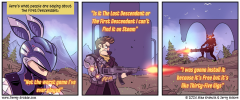You talking about the artifacts at ~0:40 ish? VSMs don't throttle new page data from directional lights at all so it's not an "in time" kind of thing. Something more significant seems to be awry there like an improperly-sized page pool perhaps. That said, in 5.4 there is some automatic mitigation for those kinds of content issues so I'm still a bit unsure as to what the problem is there. Given this is presumably some fan site grabbing content from the marketplace and just dragging sliders up though it's certainly possible they just blew past a bunch of those safeguards and are overflowing various buffers and not seeing or addressing the resulting log warnings.Still, pretty good that those are the main issues other than a few vsm tiles not getting drawn in fast enough:
Watching a bit more into the demo it does seem like they have probably improperly sized the VSM page pool and/or the Nanite pools for that resolution/settings. Many of the issues don't happen in the 1440p setup for instance. There's no reason artifacts like those in the videos should ever happen with properly set up scalability settings.
Where are you referring to in the video curiously?On straight architectural edges LOD pops become obvious,
There are definitely some limitations on that front and some energy is indeed lost if you compare to that path tracer. That said, people often conflate this with the perception side; in reality interiors often are *much* darker than exteriors on a sunny day if you measure the radiance. Because of how our eyes and perception work though, we don't really perceive them that way. HDR photography and similar make heavy use of stuff like local tone mapping/exposure to adjust this and UE does have some local exposure controls (see https://dev.epicgames.com/documentation/en-us/unreal-engine/auto-exposure-in-unreal-engine), but that part of the pipeline does require a fair amount of expertise to set up well, especially across a wide range of both HDR and SDR outputs and platforms. I expect both aspects of this will continue to evolve over time though as it's as much an artistic question as a correctness one.limited light bounces cause semi closed off areas to get incredibly dark
Last edited:








